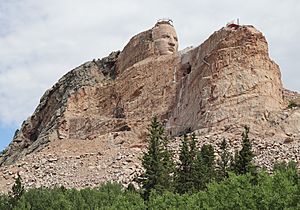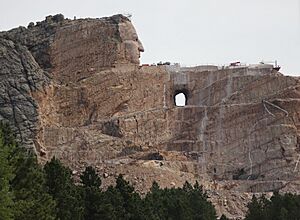Crazy Horse Memorial facts for kids

The Crazy Horse Memorial in 2020
|
|
| Coordinates | 43°50′7.45″N 103°37′16.67″W / 43.8354028°N 103.6212972°W |
|---|---|
| Location | Custer County, South Dakota, U.S. |
| Designer | Korczak Ziolkowski |
| Type | Mountain carving monument |
| Material | Leucogranite |
| Length | 641 ft (195 m) (planned) |
| Height | 563 ft (172 m) (planned) |
| Beginning date | June 3, 1948 |
| Dedicated to | Crazy Horse |
The Crazy Horse Memorial is a giant mountain sculpture being carved in the Black Hills of South Dakota, United States. It shows the famous Oglala Lakota warrior Crazy Horse riding a horse and pointing to his tribal lands. A Lakota elder named Henry Standing Bear asked sculptor Korczak Ziolkowski to create this memorial. It is run by a group called the Crazy Horse Memorial Foundation. This group is a nonprofit organization, meaning it uses its money to support the project, not to make a profit.
Work on the monument started in 1948 and is still going on today. It is a huge project that will take many years to finish.
Contents
What is the Crazy Horse Memorial?
The memorial is more than just a mountain carving. It also includes a museum called the Native American Museum of North America. There is also a Native American Cultural Center. These places help people learn about Native American history and culture.
The carving is being made from Thunderhead Mountain. This mountain is considered a special place by some Oglala Lakota people. It is located between the towns of Custer and Hill City. It is about 17 miles (27 km) from Mount Rushmore.
How Big Will the Sculpture Be?
When finished, the sculpture will be incredibly large. It is planned to be 641 feet (195 m) long and 563 feet (172 m) high. Crazy Horse's outstretched left arm will be 263 feet (80 m) long. His extended index finger alone will be 29 feet 6 inches (9 m) long.
The face of Crazy Horse was finished in 1998. It is 87 feet 6 inches (27 m) high. To give you an idea, the faces of the presidents at Mount Rushmore are each 60 feet (18 m) high.
Who Was Crazy Horse?
Crazy Horse was a brave Native American war leader. He belonged to the Oglala Lakota people. He fought against the U.S. government to protect his people's land and way of life.
He was known for his actions in battles like the Fetterman Fight in 1866. He also played a role in the Battle of the Little Bighorn in 1876. Crazy Horse surrendered in 1877. He was later hurt while resisting being held at Camp Robinson. He is remembered as one of the most important Native American leaders. The U.S. Postal Service even honored him with a postage stamp in 1982.
Building the Monument: A Long History
The idea for the Crazy Horse Memorial came from Henry Standing Bear. He was an Oglala Lakota chief and a respected elder. He wanted a monument to show that Native Americans also had great heroes. He asked Polish-American sculptor Korczak Ziolkowski to create it. Ziolkowski had worked on Mount Rushmore before.
In 1939, Henry Standing Bear wrote to Ziolkowski. He said, "My fellow chiefs and I would like the white man to know that the red man has great heroes, too." Standing Bear offered his own land to help make the project happen. The U.S. government agreed to let them use the mountain land. Standing Bear wanted the project to be funded by private donations, not government money.
Ziolkowski spent time with Standing Bear in 1940. He learned about Crazy Horse and the Lakota culture. Standing Bear was upset about broken promises, like the Treaty of Fort Laramie. This treaty had promised the Black Hills to the Native Americans forever.
Continuing the Work: The Ziolkowski Family
Korczak Ziolkowski passed away in 1982. His wife, Ruth Ziolkowski, took over the project. She decided to focus on finishing Crazy Horse's face first. She believed this would attract more visitors and bring in more money for the project. Seven of her children also helped with the work.
In 1998, Crazy Horse's head and face were completed. His eyes are 17 feet (5.2 m) wide. After the face was done, work began on the much larger horse part of the sculpture.
Ruth Ziolkowski passed away in 2014. Her daughter, Monique Ziolkowski, became the CEO. Three of her siblings and three of her grandsons continue to work on the memorial. Caleb, one of her grandsons, is now the "chief mountain officer."
Since 2014, work has focused on Crazy Horse's outstretched left arm. The memorial also expanded the Indian University of North America. This university offers summer programs for Native American students.
The memorial celebrated its 75th anniversary in 2023. Crazy Horse's left hand was finished by 2024. Work is now happening on the back of his arm. This will make way for a new, large crane. This crane will help reach all parts of the carving.
The Future Vision for the Memorial
When construction started in 1948, Ziolkowski thought it would be done in 30 years. As of 2025, there is no set date for when the monument will be fully completed. However, parts like the hand, arm, shoulder, and top of the horse's head are expected to be finished in the coming years.
The memorial is planned to be a big educational and cultural center. It will include a campus for the University of South Dakota. This campus will have classrooms and dorms. It is called the Indian University of North America. There will also be the Indian Museum of North America. The visitor center you see today will be a main part of this center.
How the Project is Funded
The Crazy Horse Memorial does not take money from the government. It is a non-profit project. The Memorial Foundation raises money in several ways. They charge fees for people to visit their centers. They also sell items in their gift shops. Many people also give private donations. Ziolkowski wanted the project to be independent. He feared that government involvement might change his plans for the educational and cultural goals.
The foundation has given over $1.2 million in scholarships. Most of these scholarships go to Native American students in South Dakota.
Different Views on the Memorial
Korczak Ziolkowski saw the monument as a way to honor Crazy Horse and all Native Americans. However, some Native Americans have different feelings about it. Crazy Horse himself did not want his picture taken. He was also buried in a secret place so his grave would not be found.
Elaine Quiver, a relative of Crazy Horse, shared her concerns in 2003. She said that Lakota culture requires family agreement for such a big decision. This agreement was not fully obtained before carving began in 1948. She felt it was disrespectful to carve the sacred Black Hills. These hills were meant for prayer and enjoyment, not for carving images.
Seth Big Crow, another relative, wondered about the money raised by the Ziolkowski family. He questioned if the project was truly about honoring Crazy Horse or about making money.
Other traditional Lakota leaders also oppose the memorial. John Fire Lame Deer, a Lakota medicine man, said in 1972 that turning a beautiful mountain into a statue was a "pollution of the landscape." Lakota activist Russell Means compared it to carving up a holy mountain in Israel. He said it was "an insult to our entire being."
Some Lakota people feel the memorial has become more about the Ziolkowski family than about Crazy Horse himself. Jim Bradford, an Oglala Sioux rancher, also said that "one non-Indian family has become millionaires off our people."
See also
 In Spanish: Monumento a Caballo Loco para niños
In Spanish: Monumento a Caballo Loco para niños
- List of colossal sculptures
- List of tallest statues
- List of the tallest statues in the United States



